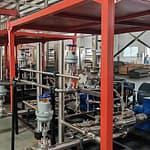Industrial Ambient Vaporizer Supplier
DSW provides cryogenic applications with direct steam-heated vaporizers and superheaters that feature unique designs to eliminate freeze-up problems at temperatures as low as -190 degC (-320 degF).
Ambient Air Vaporizers are relatively uncomplicated heat exchangers that vaporize liquified gas using heat absorbed from the ambient air.
Ambient air vaporizers take advantage of atmospheric “heat” to harness energy for the vaporization of liquid cryogen. Ambient vaporizers represent one of the most cost-effective means of vaporizing or regasifying cryogenics.
Due to this simple principle of operation, these vaporizers do not require external power.
Liquid gas passes through several interconnected tubes in various series and parallel paths.
Ambient air vaporizers operate in a wide range of applications throughout the industry.
Technical Data
| Model No. | Working Medium | Design Pressure (MPa) | Working Pressure (MPa) | Design Temperature (°C) | Heat Exchange Area (m²) |
| AV50/3.0 | Liquid Oxygen, Liquid Argon, Liquid Nitrogen | 3.3 | 3 | -196 to 50 | 12.5 |
Application of Cryogenic Vaporizer
Industrial Gas Supply:
- On-site Production: Facilities requiring a continuous supply of gaseous cryogens like oxygen, nitrogen, argon, or carbon dioxide can benefit from installing ambient vaporizers. These vaporizers allow them to vaporize the cryogenic liquids stored in tanks, providing a readily available gas source for their operations. This eliminates the need for frequent deliveries and reduces dependence on external suppliers.
- Bulk Gas Distribution: Companies distributing bulk quantities of cryogenic gases often employ ambient vaporizers at their storage facilities. These vaporizers help convert the stored liquids into gas at the desired pressure and temperature before being transferred to customer tanks or pipelines.
Manufacturing Processes:
- Metal Fabrication: Inert gas environments are crucial for various metal fabrication processes, such as welding, brazing, and cutting. Ambient vaporizers can vaporize liquid nitrogen or argon, creating a steady supply of inert gas for these operations.
- Chemical Processing: Many chemical reactions require specific gas atmospheres or cryogenic cooling. Ambient vaporizers can provide a dependable nitrogen source or other cryogenic gases for various chemical production processes.
- Food and Beverage Processing: The food and beverage industry uses cryogenic gases for freezing, inerting, and modified-atmosphere packaging. Ambient vaporizers can vaporize liquid nitrogen or carbon dioxide to support these processes.
Types of Vaporizers
The most fundamental distinction between different types of vaporizers is function. Vaporizers are used for two primary purposes: to generate a vapour or transfer heat.
Vaporizers designed to generate vapour only from a liquid flow can be used for many applications. Propane vaporizers vaporize liquid propylene (lp) to provide propane gas to equipment. It is essential for systems requiring high vapor pressure or cold environments where the natural vaporization of stored propane is insufficient. The identical vaporizers are also suitable for other fuels like gasoline or kerosene. This is most commonly used in fuel injection applications. In cryogenic applications, they can be used to superheat or vaporize low-temperature fluids such as liquid nitrogen or liquefied gas (between -280 degF and -420degF). They can also generate steam or hot gases from liquid feeds.
Heat Source
Vaporizers can be distinguished based on the heating source for the vaporized fluid.
Ambient vaporizers channel heat from the surrounding air to vaporize cryogenic and other low-temperature liquids.


DSW™ ambient vaporizers have become the industry standard, and Supergap vaporizers use natural convection of air to vaporize liquefied gases


Performance Specifications
Capacity is the rate at which liquid can be vaporized by the device, specified in gallons per hour (gph), kilograms per hour (kg/h), or similar units of quantity (mass or volume) per time. This specification is typically used to rate vaporizers designed for generating vapor rather than those for heat transfer.
The maximum temperature is the maximum operating temperature of the vaporizer, or the highest temperature the system (or heat transfer fluid) is designed to reach.
Power requirements are specified for vaporizers that use electric heat or have other equipment requiring electric power. Power is typically defined in kilowatts (kW).
Operating pressure describes the maximum pressure conditions under pressurized operation at a specified temperature (typically the maximum). Pressure is generally defined as pounds per square inch (psi).















